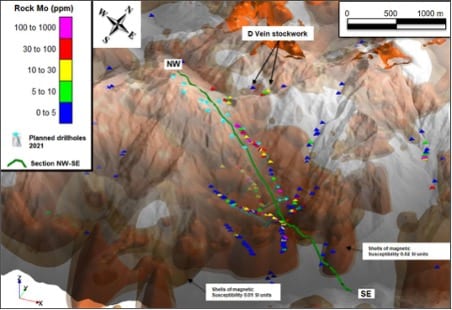Planning Underway For ENAMI EP Strategic Exploration Alliance In Ecuador
Cornerstone Capital Resources Inc(TSXV:CGP) has identified several high priority porphyry Cu-Mo (Au) drill targets identified within two main target areas at the Espejo project located within the Cornerstone Ecuador S.A. (CESA) – ENAMI EP strategic exploration alliance,
3D magnetic inversion modelling indicates strong and extensive magnetic anomalies below the 1.9km by 1.3km ESP #1 Cu-Mo (Au) anomaly and the 1.0km to 0.7km ESP #2 anomaly where anomalous Cu-Mo (Au) in rocks was confirmed by systematic soil sampling
Cornerstone’s Chief Geologist, Osman Poma, said a Phase 1 drilling programme of 30 holes for 17,000m has now been defined.
“We and our partner, Ecuador’s state mining company ENAMI, are pleased to announce this update on the Espejo block of concessions within the ENAMI-CESA SEA,” Mr Poma said.
“The age of the intrusions and the style of mineralisation at Espejo are similar to those found at the Llurimagua Cu Mo porphyry deposit located in the same geological belt, some 80 km to the southwest.
“Our surveys have delineated well-defined geochemical anomalies associated with porphyry style veining in outcrop and large magnetic bodies.
“Subject to permitting and securing a suitable funding partner and farm-in arrangement, drilling of these targets is planned during the 4th quarter of 2021 or the first quarter of 2022.”
The targets
Anomaly ESP # 1
3D magnetic inversion modelling was carried out on target areas at Espejo. Data show a strong and extensive magnetic anomaly below the Cu-Mo (Au), 1.9km by 1.3km, ESP #1 rock and soil anomaly. The geochemically anomalous zone is fully open to the NW where porphyry style mineralisation and veining was found in the creeks some 500m in this direction. The SE-NW cross-section shows the shape and large size of the multiple magnetic bodies that extend from surface to > 1500m below surface.
Geological mapping indicates that these magnetic bodies are associated to an intrusive complex centred right below the anomalous zone. A Phase 1 drilling programme (20 holes and 12,000 metres) was preliminarily defined. This planning will be refined in the coming months, once further mapping and sampling is completed.
Anomaly ESP # 2
Similar magnetic data processing and modelling were performed on the ESP #2 anomaly where anomalous Cu-Mo (Au) in rocks were confirmed by systematic soil, showing a perfect overlap of these three elements. The Cu/Zn ratio defines a NW-SE oriented, 1.0km by 0.7km, soil anomaly open to the east and southeast.
Initial channel sampling yielded highly anomalous Cu and Mo results (Figure 6) associated to potassic and phyllic altered intrusives and volcanic host rocks: 1) 16.2m at 0.24 g/t Au, 455 ppm Cu and 48 ppm Mo, 2) 33.5m at 0.12 g/t Au, 500 ppm Cu and 27 ppm Mo, 3) 15.9m at 757 ppm Cu and 64 ppm Mo, and 4) 76.2m at 280 ppm Cu and 34 ppm Mo. Several magnetic bodies are present at depth. Although still incomplete, all data collected to date was integrated to define a conceptual Phase 1 drilling programme (10 holes and 5,000 metres) for testing the surface (geology and geochem) and sub-surface (magnetic) anomalies
Further mapping and sampling is ongoing on this target with the objective to complete modelling and better characterize/prioritise individual targets to be drill-tested later this year.












